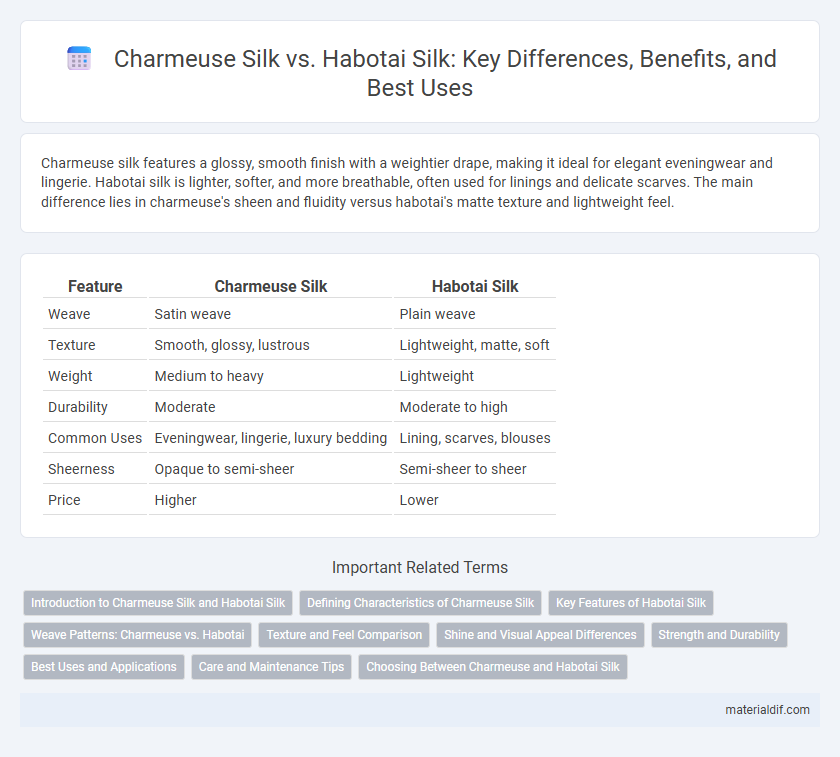Charmeuse silk features a glossy, smooth finish with a weightier drape, making it ideal for elegant eveningwear and lingerie. Habotai silk is lighter, softer, and more breathable, often used for linings and delicate scarves. The main difference lies in charmeuse's sheen and fluidity versus habotai's matte texture and lightweight feel.
Table of Comparison
| Feature | Charmeuse Silk | Habotai Silk |
|---|---|---|
| Weave | Satin weave | Plain weave |
| Texture | Smooth, glossy, lustrous | Lightweight, matte, soft |
| Weight | Medium to heavy | Lightweight |
| Durability | Moderate | Moderate to high |
| Common Uses | Eveningwear, lingerie, luxury bedding | Lining, scarves, blouses |
| Sheerness | Opaque to semi-sheer | Semi-sheer to sheer |
| Price | Higher | Lower |
Introduction to Charmeuse Silk and Habotai Silk
Charmeuse silk is a luxurious fabric characterized by its satin weave, offering a smooth, glossy surface and a lightweight, draping quality ideal for evening wear and lingerie. Habotai silk, also known as China silk, features a plain weave with a soft, matte finish and a lightweight, breathable texture commonly used for linings and lightweight garments. Both charmeuse and habotai silks are prized for their comfort and elegance but differ significantly in texture, sheen, and typical applications.
Defining Characteristics of Charmeuse Silk
Charmeuse silk is distinguished by its lustrous, smooth surface and high sheen, making it ideal for luxury garments and elegant drapery. Its dense weave creates a heavier, satin-like fabric that contrasts with the lightweight, matte finish of Habotai silk. Known for rich texture and excellent drape, Charmeuse silk offers a glossy, fluid appearance that enhances the sophistication of any design.
Key Features of Habotai Silk
Habotai silk, known for its lightweight and smooth texture, is often favored for lining garments and delicate scarves due to its breathable and soft properties. Unlike charmeuse silk, habotai has a plain weave that provides a matte finish and greater durability while maintaining a luxurious feel. Its affordability and versatility make habotai ideal for both fashion and upholstery applications where a subtle sheen and comfortable touch are desired.
Weave Patterns: Charmeuse vs. Habotai
Charmeuse silk features a satin weave pattern that creates a smooth, glossy front with a dull back, lending the fabric a luxurious sheen and fluid drape ideal for eveningwear and lingerie. Habotai silk utilizes a plain weave pattern, producing a lightweight, breathable fabric with a matte finish and a slightly crisp texture suited for linings and lightweight garments. The contrasting weave structures directly influence the fabrics' appearance, texture, and best-use applications in fashion and textiles.
Texture and Feel Comparison
Charmeuse silk features a smooth, glossy surface with a luxurious sheen that feels soft and fluid against the skin, making it ideal for elegant garments. Habotai silk has a lighter, matte finish with a crisp texture that provides breathability and a comfortable, cool feel, often preferred for linings and summer wear. The distinct tactile contrast between Charmeuse's silky drape and Habotai's lightweight structure defines their unique applications in silk textiles.
Shine and Visual Appeal Differences
Charmeuse silk exhibits a glossy, lustrous shine due to its satin weave, creating a smooth surface that reflects light brilliantly, enhancing its visual appeal with a rich, luxurious sheen. In contrast, Habotai silk features a matte finish with a softer, subtle shine resulting from its lighter, plain weave, offering a more understated elegance. Charmeuse silk's reflective quality makes it ideal for formal wear and evening gowns, whereas Habotai silk suits linings and casual apparel where a delicate, gentle shimmer is preferred.
Strength and Durability
Charmeuse silk, known for its satin weave, offers exceptional strength and durability compared to Habotai silk's plain weave structure. The tight, glossy finish of Charmeuse enhances its resistance to wear and tear, making it ideal for luxurious garments and accessories requiring longevity. Habotai silk, while lightweight and smooth, is less durable and more prone to fraying under frequent use.
Best Uses and Applications
Charmeuse silk's smooth, glossy surface and substantial weight make it ideal for luxurious evening gowns, lingerie, and high-end bedding, offering a rich drape and elegant shine. Habotai silk, known for its lightweight and breathable texture, is perfect for linings, casual apparel, and summer scarves, providing comfort and softness without bulk. Both fabrics excel in specific applications where weight, sheen, and durability align with garment design and intended use.
Care and Maintenance Tips
Charmeuse silk, known for its glossy surface and smooth texture, requires gentle hand washing in cold water and air drying away from direct sunlight to maintain its sheen and prevent fabric damage. Habotai silk, lighter and softer, benefits from similar care but is more resilient to delicate machine washes on a gentle cycle using mild detergent. Both silks should be stored in a cool, dry place away from plastic to allow breathability and avoid moisture buildup that can weaken fibers.
Choosing Between Charmeuse and Habotai Silk
Charmeuse silk features a smooth, lustrous finish with a heavier weight, making it ideal for eveningwear and luxury fashion due to its drape and sheen. Habotai silk is lighter, matte, and breathable, preferred for linings and casual garments that require softness without shine. Choosing between Charmeuse and Habotai silk depends on the desired texture, weight, and sheen suitable for the final garment's function and aesthetic.
Charmeuse Silk vs Habotai Silk Infographic

 materialdif.com
materialdif.com